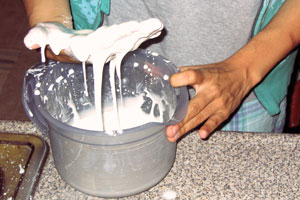 Water and cornstarch make a non-Newtonian fluid when mixed: messy but great fun!Sixth grade was a big year for science fair projects in my hometown. I was fascinated by sound and decided to test whether high or low pitches traveled more easily. In principle this could have been a great idea, but I soon discovered that having family members lie down on the living room floor trying to listen while a beige plastic Fisher Price cassette player honked various toots and tweets from the adjacent room just wasn't going to work out as well as I had hoped.
Water and cornstarch make a non-Newtonian fluid when mixed: messy but great fun!Sixth grade was a big year for science fair projects in my hometown. I was fascinated by sound and decided to test whether high or low pitches traveled more easily. In principle this could have been a great idea, but I soon discovered that having family members lie down on the living room floor trying to listen while a beige plastic Fisher Price cassette player honked various toots and tweets from the adjacent room just wasn't going to work out as well as I had hoped.
Fast-forward fifteen years to the beginning of the present school year and the Internet has given us all a huge leg-up in finding hands-on ways to learn science. These are demonstrations rather than experiments--an important difference for those entering a fair. Nevertheless, I have included two of my favorites below.
Homemade Oobleck:
Pay tribute to Dr. Seuss's book Bartholomew and the Oobleck by whipping up this mixture that is both solid and liquid at the same time! The simplest version is listed below, but adding a few more bells and whistles can increase the demonstration's awe-factor a bunch.
What to do: You need a mixing bowl, water, and cornstarch. Fill the mixing bowl with about 1 cup of cornstarch, and add roughly an equal volume of water. Mix, incrementally adding cornstarch or water until the mixture attains an appropriate blend of goopiness and firmness. Enjoy the fluid's bizarre properties by squishing and kneading it with your hands.
